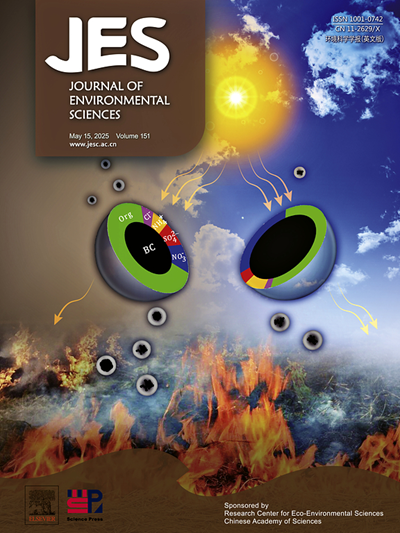冻融和酸化的耦合作用如何影响原生锌冶炼渣中有毒元素的释放?
IF 5.9
2区 环境科学与生态学
Q1 ENVIRONMENTAL SCIENCES
引用次数: 0
摘要
在冻融循环(FTs)和酸化耦合作用等复杂现场条件下,原生锌冶炼渣(ZSS)中潜在有毒元素(pte)的浸出行为与矿物学(如矿物颗粒的组成、组合、微观结构)有着复杂的联系。在本研究中,进行了FTs测试,以探索PTEs释放与ZSS矿物学之间的相互作用。随后,采用先进的表征技术对ZSS的矿物学和微观结构进行了量化。结果表明:ZSS主要由石英、黑云母和绿泥石等硅酸盐矿物和磁铁矿、褐铁矿等次生铁(III)氢氧化物组成,分别占67.48%和24.23%;赋存模式分析表明,81.95%的As、21.31%的Pb和7.77%的Zn赋存于褐铁矿中。Cd、Pb和Zn的37.89%、59.34%和34.50%与碳酸盐结合馏分有关。在ft与不同pH条件相互作用下,As、Cd、Cu、Pb和Zn的浸出浓度并没有随着ft和pH的增加而显著增加。高孔隙率ZSS中矿物颗粒的微观结构破坏是由ft和质子腐蚀共同造成的。更重要的是,地球化学模拟结果表明,赤铁矿和磁铁矿的沉淀以及砷化岩的溶解可能对ft和酸化ft下pte的释放影响不大。这项工作将为冶炼废渣在复杂的物理化学相互作用下释放pte提供更深入的认识。本文章由计算机程序翻译,如有差异,请以英文原文为准。

How does the coupled action of freeze-thaw and acidification affect the release of toxic elements from indigenous Zn smelting slags?
Under complicated field conditions, such as the coupled effects of freeze - thaw cycles (FTs) and acidification, the leaching behavior of potentially toxic element (PTEs) from indigenous Zn smelting slags (ZSS) was intricately connected to the mineralogy (e.g., the composition, assemblage, microstructure of mineral particles). In this study, FTs tests were carried out to explore the interactions between PTEs release and ZSS mineralogy. Subsequently, advanced characterization techniques were adopted to quantify the mineralogy and microstructure of ZSS. The results indicated that ZSS were mainly composed of silicate minerals (e.g., quartz, biotite and chlorite) and secondary Fe (III) oxyhydroxides (e.g., magnetite and limonite), accounting for 67.48% and 24.23%, respectively. The occurrence mode analysis revealed that 81.95% of As, 21.31% of Pb and 7.77% of Zn were hosted in limonite. About 37.89%, 59.34% and 34.50% of Cd, Pb and Zn were associated with carbonate bound fractions. Under FTs interacting with different pH conditions, the leaching concentrations of As, Cd, Cu, Pb and Zn did not significantly increase with the increase in FTs and pH. The microstructure damage of mineral particles in ZSS with the higher porosity was caused by both FTs and proton corrosion. More importantly, the geochemical modeling results suggested that the precipitation of hematite and magnetite, as well as the dissolution of arsenolite, might have little impacts on PTEs release under FTs and FTs with acidification. This work would provide a deeper understanding of PTEs release from smelting waste slags under complex physicochemical interactions.
求助全文
通过发布文献求助,成功后即可免费获取论文全文。
去求助
来源期刊

Journal of Environmental Sciences-china
环境科学-环境科学
CiteScore
13.70
自引率
0.00%
发文量
6354
审稿时长
2.6 months
期刊介绍:
The Journal of Environmental Sciences is an international journal started in 1989. The journal is devoted to publish original, peer-reviewed research papers on main aspects of environmental sciences, such as environmental chemistry, environmental biology, ecology, geosciences and environmental physics. Appropriate subjects include basic and applied research on atmospheric, terrestrial and aquatic environments, pollution control and abatement technology, conservation of natural resources, environmental health and toxicology. Announcements of international environmental science meetings and other recent information are also included.
 求助内容:
求助内容: 应助结果提醒方式:
应助结果提醒方式:


